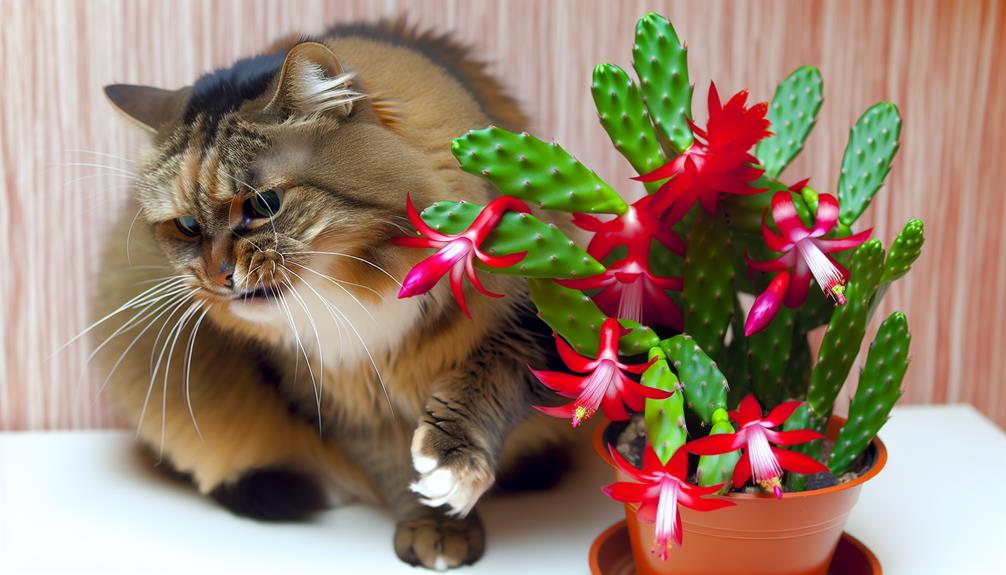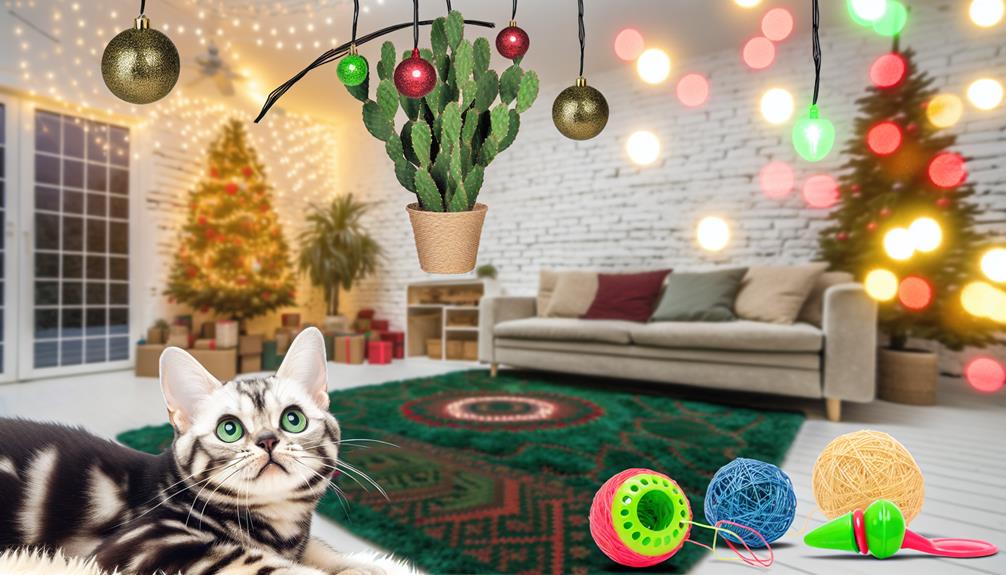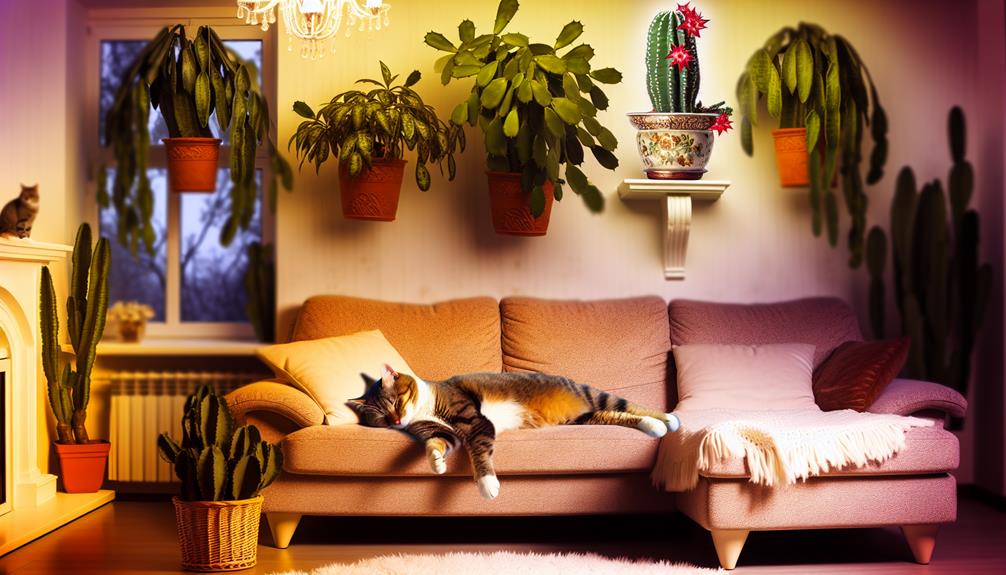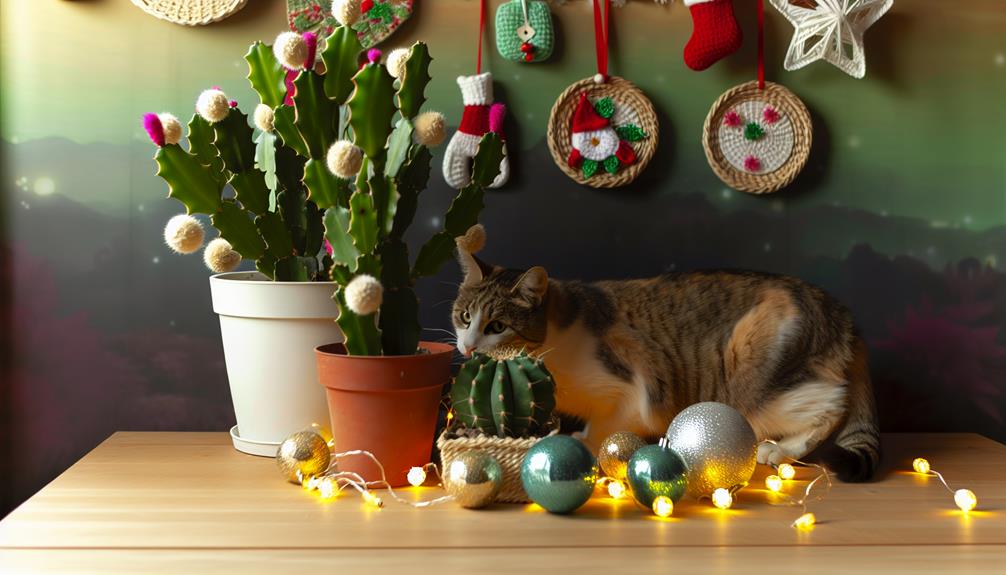You might think that Christmas cacti are a safe addition to your home décor, but have you ever considered how they affect your feline friends? While they're not severely toxic, these plants can cause mild discomfort in cats, leading to symptoms like drooling and lethargy. It's essential to know what to watch for and how to act if your cat takes a nibble. Curious about how to create a safer environment for your pets during the festive season? Let's explore the nuances and guarantee your holiday decorations are both beautiful and pet-friendly.
Christmas Cactus Overview
To begin with, the Christmas Cactus, scientifically known as Schlumbergera, is a popular houseplant recognized for its vibrant, tubular flowers that bloom around the holiday season. This makes it a favored choice for adding a splash of color to your home during the colder months. However, to keep this plant thriving, understanding Christmas Cactus care is essential.
When it comes to Christmas Cactus care, you'll find that it requires a bit more attention compared to other succulents. Unlike its desert-dwelling relatives, the Christmas Cactus prefers a humid environment and well-draining soil. Watering should be done moderately; overwatering can lead to root rot, while underwatering can cause the plant to wilt. It's advisable to let the top inch of soil dry out before watering again. Additionally, the plant benefits from indirect, bright light, making it ideal for placement near windows that don't receive direct sunlight.
The benefits of having a Christmas Cactus in your home during the holidays extend beyond its aesthetic appeal. This holiday plant can improve indoor air quality by absorbing carbon dioxide and releasing oxygen. Furthermore, the process of caring for the plant can have therapeutic effects, providing a sense of accomplishment and a calming routine.
Toxicity Levels
You might be concerned about the Christmas Cactus's toxicity levels for your cat. While it's considered mildly toxic, ingestion can lead to gastrointestinal discomfort. To mitigate risks, consider opting for safe plant alternatives that pose no threat to your feline friend.
Mildly Toxic Symptoms
Understanding the mildly toxic symptoms of Christmas cactus ingestion in cats is vital for pet owners. While the Christmas cactus is not among the most hazardous plants, monitoring your feline companion for signs of discomfort after ingestion is a significant aspect of plant care and cat safety. Mild toxicity may manifest as drooling, lethargy, or a slight decrease in appetite. These symptoms indicate that your cat's system is reacting to the plant's components.
In some cases, a mildly toxic reaction can include minor irritations, such as oral discomfort and inflammation. You might notice your cat pawing at their mouth or exhibiting increased thirst. These signs, while not severe, require observation to guarantee that the symptoms do not escalate.
To mitigate risks, make sure the Christmas cactus is placed in an area that is inaccessible to your cat. This preventive measure aligns with best practices in plant care and cat safety, minimizing the likelihood of ingestion. Always consult your veterinarian if you suspect your cat has ingested any part of the plant, even if symptoms appear mild. Early intervention can prevent complications and guarantee your cat remains healthy and comfortable.
Gastrointestinal Discomfort Risks
Gastrointestinal discomfort is a common risk associated with the ingestion of Christmas cactus by cats, even though the plant's overall toxicity level is relatively low. When a cat consumes parts of this plant, symptoms such as vomiting, diarrhea, and loss of appetite may occur. These symptoms are typically mild but can cause considerable discomfort for your feline friend. It's vital to understand how a cat's dietary habits influence its reaction to different plants, including the Christmas cactus.
Cats are obligate carnivores, meaning their digestive systems are not well-suited to processing plant material. Ingesting Christmas cactus can upset their gastrointestinal tract, leading to the aforementioned symptoms. While the plant itself is not highly toxic, the irritation it causes can still be significant. Monitoring your cat's behavior and dietary habits can help you identify any adverse reactions early on.
For the sake of plant safety, it's important to make sure your Christmas cactus is placed in an area inaccessible to your cat. While the risks are relatively low compared to other more toxic plants, understanding the potential for gastrointestinal issues will help you maintain a safer environment for your pet. Always consult your veterinarian if symptoms persist or worsen.
Safe Plant Alternatives
When considering safe plant alternatives for your home, it is crucial to evaluate the toxicity levels of various species to guarantee they pose no threat to your feline companions. Some plants, while aesthetically pleasing, can be harmful if ingested by cats, causing anything from mild gastrointestinal discomfort to severe poisoning. As a result, a careful selection of non-toxic plants is paramount for a safe indoor gardening environment.
One excellent choice is the spider plant (Chlorophytum comosum), which is non-toxic to cats and thrives indoors. Additionally, herbs like catnip (Nepeta cataria) and valerian (Valeriana officinalis) serve as both safe plants and herbal remedies that cats often enjoy. Basil (Ocimum basilicum) and rosemary (Rosmarinus officinalis) are also safe and can enhance your indoor garden's aroma while posing no threat to your pets.
For those seeking flowering options, African violets (Saintpaulia) and orchids (Orchidaceae) are both non-toxic and add vibrant colors to your home. By focusing on these safe plant alternatives, you can cultivate a beautiful, cat-friendly indoor garden that supports your feline's well-being without compromising on aesthetics or functionality.
Symptoms in Cats

If your cat ingests any part of a Christmas cactus, you might notice signs of gastrointestinal distress such as vomiting or diarrhea. Behavioral changes, including lethargy or increased agitation, can also be observed. In such cases, immediate veterinary consultation is essential to guarantee your cat's health isn't compromised.
Gastrointestinal Distress Signs
Spotting the early signs of gastrointestinal distress in your cat is vital for timely intervention. When evaluating cat behavior, look for symptoms such as vomiting, diarrhea, loss of appetite, or lethargy. These indicators can suggest that your feline has ingested something potentially harmful, like parts of a Christmas cactus. While Christmas cacti are generally considered non-toxic, they can still cause discomfort and gastrointestinal upset when consumed.
Pay attention to changes in your cat's eating habits. Refusal to eat or sudden changes in food preferences can be a red flag. Additionally, excessive drooling or difficulty swallowing might indicate irritation in the mouth or throat, often stemming from plant ingestion.
Diarrhea and vomiting are clear signs your cat's digestive system is in distress. These symptoms can lead to dehydration, so it's essential to guarantee your pet stays hydrated. If vomiting or diarrhea persists for more than 24 hours, consult your veterinarian.
Lastly, monitor for signs of lethargy or unusual tiredness. This can be a subtle yet significant indicator of discomfort or illness. Prioritizing plant safety and recognizing these symptoms early can help mitigate the adverse effects on your cat's health.
Behavioral Changes Observed
Behavioral changes in cats, such as altered grooming habits or increased hiding, can be key indicators of underlying health issues. When your cat exhibits unusual behavior, it might be responding to something in its environment. Cats are naturally curious, and their intrigue with plants, like the Christmas cactus, can sometimes lead to unexpected consequences.
One of the first signs you might notice is a sudden change in grooming behavior. Cats are meticulous groomers, so if your feline friend starts grooming excessively or neglects its grooming routine altogether, this deviation could be a response to discomfort or irritation. Additionally, cats may start hiding more frequently. Increased hiding can indicate that your cat is feeling unwell or stressed, possibly from ingesting or interacting with a harmful substance.
Another behavioral change to watch for is a shift in activity levels. If your normally active cat becomes lethargic or displays unusual restlessness, these changes in cat behavior might be linked to its recent plant curiosity. Monitoring such behavioral changes is essential, as they often provide the first clues that something is amiss. Being vigilant about these signs can help you identify potential issues early, ensuring your cat's well-being.
Immediate Veterinary Consultation
Recognizing these behavioral changes in your cat is just the beginning. If your cat exhibits symptoms like vomiting, diarrhea, or lethargy after interacting with a Christmas Cactus, prompt action is essential. You need to initiate an emergency response by contacting your veterinarian immediately. These symptoms, while not always severe, can escalate if not addressed promptly.
Veterinary advice is indispensable in such scenarios. Your vet will likely ask for a detailed account of the symptoms and any potential ingestion of the plant. It's important to provide as much information as possible to facilitate accurate diagnosis and appropriate treatment. Emergency response measures may include inducing vomiting, administering activated charcoal, or providing IV fluids to prevent dehydration.
Don't attempt to treat your cat at home without professional guidance. Some home remedies can exacerbate the condition. Always prioritize professional veterinary advice for any suspected poisoning. Quick intervention can notably improve your cat's prognosis and reduce the risk of long-term health issues. Immediate veterinary consultation guarantees that your cat receives the most effective and timely care, safeguarding their well-being and giving you peace of mind.
Safe Alternatives
When considering safe alternatives to the Christmas cactus for households with cats, it is essential to identify non-toxic plants that still provide aesthetic appeal. One of the most effective strategies is to select herbal options known for their safety and visual attractiveness. For instance, catnip (Nepeta cataria) not only offers a pleasing appearance but also provides a delightful treat for your feline companion. Similarly, rosemary (Rosmarinus officinalis) serves as both an appealing and aromatic addition to your home decor, while remaining completely safe for cats.
Non-toxic flowers can also be an excellent choice. African violets (Saintpaulia) are particularly notable for their vibrant hues and easy maintenance. These plants offer a splash of color without posing a risk to your pets. Orchids, another non-toxic alternative, provide an exotic flair and are available in a range of colors and sizes, making them a versatile option for various interior designs.
For those who prefer greenery, spider plants (Chlorophytum comosum) and Boston ferns (Nephrolepis exaltata) are both excellent choices. These plants are not only safe for cats but also help improve indoor air quality, adding an extra layer of benefit to their inclusion in your home.
Preventive Measures

Preventive measures are essential in guaranteeing your household remains a safe environment for both your Christmas cactus and your cats. Understanding plant care and cat behavior is critical to mitigating any risks associated with your feline companion's curiosity.
First, consider the placement of your Christmas cactus. Position the plant in an area that's out of reach for your cat, such as a high shelf or a hanging planter. This minimizes the chance of your cat interacting with the plant. Confirm the location still provides adequate light and meets the other care requirements of your Christmas cactus, such as moderate indirect sunlight and proper humidity levels.
Next, observe and analyze your cat's behavior. Some cats are more inclined to explore and chew on household items, including plants. If your cat exhibits such tendencies, consider employing deterrents. A common method involves using citrus sprays or placing orange peels around the base of the plant, as cats typically dislike citrus scents.
Additionally, provide your cat with alternative sources of stimulation to curb its interest in the Christmas cactus. Cat grass or catnip plants can serve as safe and appealing distractions. Regular playtime and the use of engaging toys can also reduce your cat's inclination to investigate the cactus.
Lastly, utilize physical barriers if necessary. Mesh screens or decorative fencing can serve as effective deterrents without compromising the aesthetic appeal of your living space. By incorporating these preventive strategies, you can create a harmonious environment that caters to both ideal plant care and the well-being of your cat.
What To Do If Ingested
If your cat ingests part of your Christmas cactus, immediate action is crucial to guarantee its safety. While the Christmas cactus is generally not toxic to cats, ingestion can still cause gastrointestinal upset or other symptoms. Here are some ingestion protocols and emergency responses to follow.
First, observe your cat closely for any signs of distress such as vomiting, diarrhea, or lethargy. These symptoms can indicate that your cat's digestive system is irritated. If any of these symptoms are present, it's essential to take swift action.
Second, try to determine how much of the plant was ingested. This will help your veterinarian assess the situation more accurately. If you suspect a significant amount was consumed, contact your vet immediately for professional advice.
Third, do not attempt to induce vomiting unless instructed by a vet. Inducing vomiting improperly can cause further harm, including aspiration or esophageal damage.
Fourth, provide your cat with plenty of fresh water to help flush out any toxins. However, do not force your cat to drink; simply make water readily available.
Here's a quick reference table for your convenience:
| Step | Action |
|---|---|
| Observe Symptoms | Watch for vomiting, diarrhea, lethargy |
| Assess Amount Ingested | Determine how much plant was eaten |
| Contact Veterinarian | Call vet if significant ingestion occurred |
| Provide Water | Make sure fresh water is available |
Creating a Pet-Friendly Home

While it's important to manage incidents of ingestion, guaranteeing your home is pet-friendly can help prevent such occurrences altogether. A proactive approach in creating a safe environment for your cats involves several key strategies. First, consider incorporating pet safe decorations. Opt for non-toxic materials and avoid items that can be easily ingested or cause harm if broken. For example, glass ornaments can be replaced with shatterproof alternatives, and tinsel, which is hazardous if swallowed, should be omitted entirely.
Holiday plant care is another vital aspect to focus on. While Christmas cacti are generally non-toxic to cats, other holiday plants like poinsettias, mistletoe, and holly can pose considerable risks. Confirm that these plants are either kept out of reach or replaced with safer options. If you insist on having these plants, consider placing them in rooms or areas that your cat cannot access.
Additionally, think about the placement of your decorations. Securely anchor your Christmas tree to prevent it from tipping over if your cat decides to climb it. Use cord protectors to shield electrical wires from curious pets, and avoid using candles or verify they are placed where your cat cannot reach them.
Creating a pet-friendly home extends beyond just the holiday season. Regularly inspect your living spaces for potential hazards and adjust accordingly. By incorporating pet safe decorations and being mindful of holiday plant care, you can greatly reduce the risk of harmful incidents. These measures not only protect your feline friends but also contribute to a safer, more harmonious household environment.
Conclusion
To keep your cat safe, be vigilant, be proactive, and be informed. Monitor your Christmas cactus, observe your pet, and consult your vet if needed. While Christmas cacti aren't severely toxic, they can still cause discomfort. Opt for safe alternatives, take preventive steps, and create a pet-friendly home. By doing so, you'll guarantee a happy, healthy environment for your furry friend, free from unnecessary risks and filled with love and care.
